Overview
As we head into the second half of the year, we continue to hold views that differ from the consensus. From expectations for macroeconomic growth and inflation, through to the actions of central banks and the subsequent path for interest rates, we believe that investors could be in for a surprise or two.
What we expect in the coming months:
- Stronger growth than anticipated by markets and investors
- Central banks to be patient and interest rates to rise with only a gradual trajectory
- Equity markets to be dominated by rotation rather than directionality and for volatility not to break range
These expectations suggest room for the risk premia of equities and real assets to compress further over the coming months.
While The Consensus and Markets Say Yes…
Regarding the global economic cycle, the consensus outlook is very clear: GDP growth will have peaked in Q2 2021. The current view shared by most economists and central bankers is that the peak of ISM, payroll and retail sales data, as well as of China’s credit impulse and M2, is now behind us. The expectations are now for a gradual return to potential growth, which will be reached during the course of next year. Figure 1 illustrates this expected path through the quarterly consensus forecasts for the US and Eurozone economies.
Figure 1: Consensus Forecasts for US and Eurozone GDP
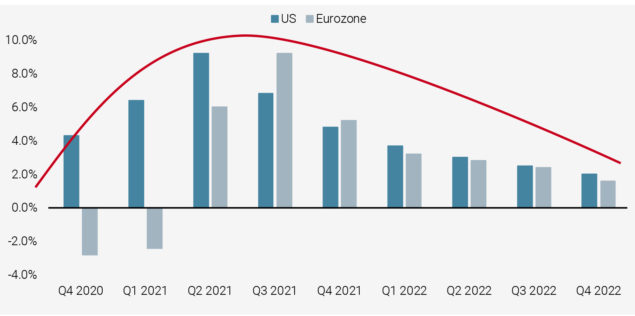
Sources: Bloomberg, Unigestion. Data as at 31.05.2021.
In this context, the rise in inflation observed since the beginning of the year, which is the result of a combination of rising commodity prices and a lack of significant investment in many sectors constraining supply and limiting the efficiency of the supply chain, is therefore expected to be temporary.
…Our Nowcasters Tell a Different Story
However, our proprietary Nowcaster and Newscaster indicators, which track the business cycle and inflation risk in real time via the aggregation of several hundred macroeconomic, financial and media data series, suggest a different perspective. Their indications highlight the exceptional nature of the current situation via two key findings:
- The Global Growth Nowcaster is at its highest level since 1985 (Figure 2)
- The very balanced distribution of contributors, both in terms of sectoral components and geographical areas (Figure 3)
Figures 2 & 3: Global Growth Nowcaster and its Breakdown by Country and Component
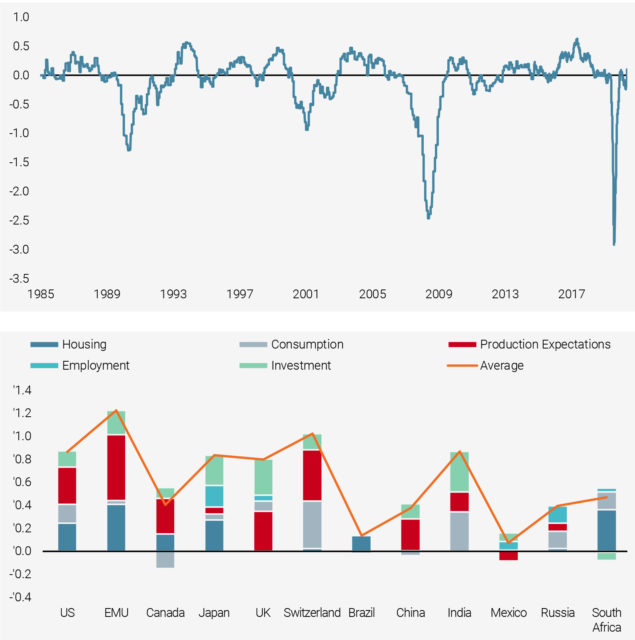
Source: Bloomberg, Unigestion. Data as at 31.05.2021.
Our historical analysis shows that this level of growth typically lasts longer than what current pricing indicates. We have studied the dynamics of Nowcasters, analysing the average growth rate after it reaches a high level and its stability in terms of how long growth remains at this high rate. In our view, we have only seen one part of the economic recovery. This is the growth coming from the rebound in industrial and manufacturing activity that has been enabled by the resumption in global trade.
Because of the social distancing measures still in place in many parts of the world, the „Consumption“ component, particularly that of services, has not yet regained its pre-crisis momentum or its contribution to growth. However, the consumption of services is a major creator of jobs. In the coming months, we believe that demand for services will benefit from:
- Reopening/vaccination, which will allow people to move more freely
- The exceptional level of savings, which will support a strong increase in consumption by households as well as by companies via investment
Our analysis of the components of the Global Growth Nowcaster (Figure 4) highlights perfectly the scale of the potential from the demand side to support global growth in the coming quarters while „Employment“ and „Consumption“ remain below the average levels observed during the previous expansions.
Figure 4: Global Growth Nowcaster Components
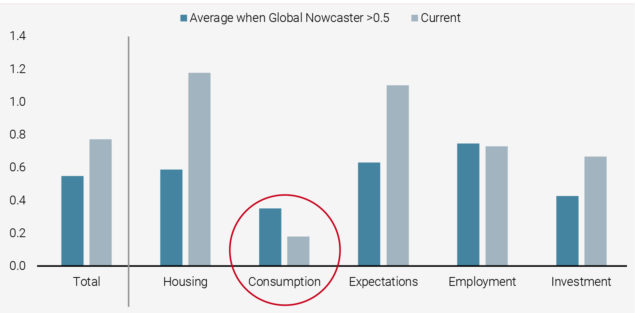
Source: Bloomberg, Unigestion. Data as at 31.05.2021.
The situation is similar for our Inflation Nowcaster, which is also up sharply to levels not seen since 1985 and has the same characteristics in terms of homogeneity of contributors (Figure 5).
Figure 5: Inflation Nowcaster Components
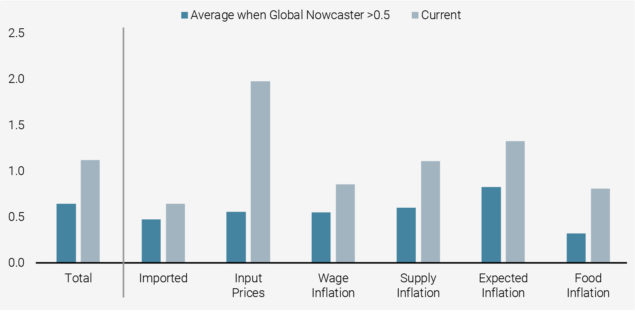
Source: Bloomberg, Unigestion. Data as at 31.05.2021.
This trend is also reflected in several of the inflation indicators developed by the regional Federal Reserve banks (Figure 6). In our view, US Core PCE inflation should overshoot the 2% threshold on a sustained basis on the back of a strong and rapid recovery in the labour market and we anticipate that aggregate wage costs may emerge at considerably higher levels of headline unemployment in this cycle.
Figure 6: Fed Inflation Monitor
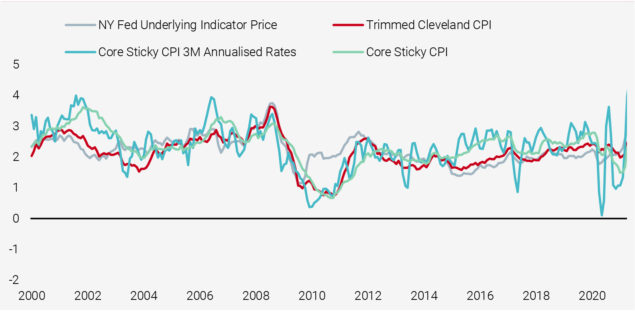
Source: US Federal Reserve. Data as at 31.05.2021.
Despite Record Nominal Growth, We Expect Central Banks to Remain Patient…
The expected boost from consumption will likely have two important impacts: a significant drop in unemployment rates and a longer period of inflation at high levels. Indeed, regarding inflation dynamics, we believe that the „supply shortage“ effect, which drove input prices (or the „prices paid“ component of the surveys) to record levels in Q1 2021, will be joined by the „higher demand“ effect. These two factors should challenge the very accommodative bias of monetary policy around the end of the summer, i.e. earlier than current pricing would suggest, leading to a change in stance at the beginning of next year at the earliest. In fact, the central banks‘ guidelines or forecasts could be adjusted earlier than expected in terms of unemployment rate and inflation dynamics.
Nevertheless, while we expect a rise in real bonds yields in the coming months, because they are currently at low levels based on both history and fundamentals (Figures 7 and 8), we do not anticipate central banks suddenly waking up to inflation risks and triggering a crash in bonds. Firstly, because today, „don’t fight the Fed“ translates as „higher real bond yields“. Indeed, any gradual increase in real bond yields would be seen as a sign of a solid and sustainable recovery and a source of reconstituted ammunition for the next crisis. Secondly, because in the case of a sudden spike in real bond yields, central banks have a large spectrum of tools to cap any overshoot.
Following publication of the minutes from the June FOMC meeting, which showed changes in dot projections for 2023 and highlighted discussions about the timing of tapering, US inflation breakevens declined. This illustrates how credible the Fed remains for bonds vigilance. We therefore think that upcoming central bank meetings will likely be used to reassure investors that policymakers are unlikely to change course anytime soon. Moreover, any changes in the stance of monetary policy would be very well telegraphed and gradual.
Figures 7 & 8: Real Rates and Nominal Rates vs Fundamentals
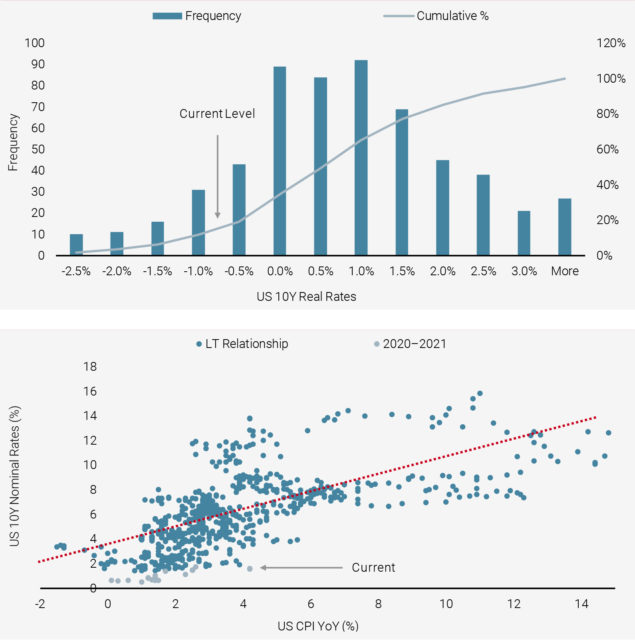
Source: Bloomberg, Unigestion. Data as at 31.05.2021.
…Supporting Cyclical and Real Assets
Our Macro/Sentiment/Valuation framework, which has been developed to allocate our risk dynamically, currently exhibits a very favourable context for real and growth assets. On one hand, continued abovetrend growth in the second half of the year, combined with central banks continuing to err on the side of caution, should help drive the next leg of the rally in global equities. On the other hand, with regard to market sentiment, which combines positioning, risk appetite and asset performance velocity, we think that active and aggressive fiscal policies have limited the scarring effects and kept private sector risk appetites buoyant.
Given the strong market rally we have observed since April last year, valuations could become a headwind. Nevertheless, we think that the uneven impact on low-income households has also meant that policy makers should err on the side of providing more accommodation to ensure an inclusive recovery. Macro policies should therefore stay much more expansionary in this cycle relative to historical recoveries at a similar stage. Consequently, we expect expensive valuations to stay limited to only certain segments thanks to a combination of a sharp growth rebound and a low level of bond yields.
In a context of higher inflation and higher growth, we favour cyclical commodities that exhibit attractive valuations relative to history thanks to the current backwardation of the forward curve (Figure 9). Moreover, as we expect a broader and stronger expansion than consensus led by capex linked to both infrastructure investment and climate transition, real assets should outperform income and defensive assets.
Figure 9: Historical Valuation Indicator
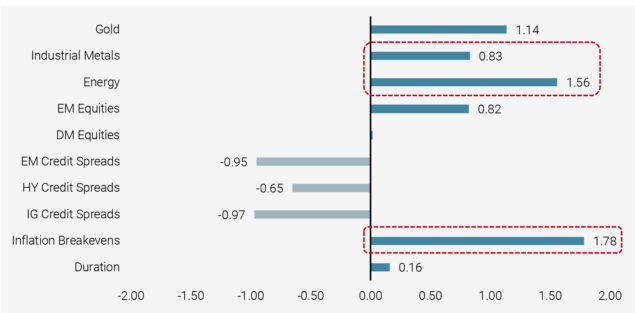
Source: Bloomberg, Unigestion. Data as at 31.05.2021.
Next is for the market to realise that the macro momentum peak is not behind us, there are no signs that it will slowdown meaningfully and that activity levels will remain robust in the second half of the year, leading to a continued positive earnings tailwind. That might be confirmed as we go through the summer, especially as consumption and capex continue to grow.
Against such a backdrop of higher-than-forecast inflation, investors should favour businesses with pricing power that can improve their margins if input prices increase. Consequently, with the first phase of reflation-triggered rotation across and within assets through a sensitivity to higher bond yield analysis, we think that the expansion will likely lead to more discrimination based on the difference between „price maker“ and „price taker“.
In this context, we continue to favour assets that combine high cyclical sensitivity and moderate valuations. Within equity indices, European, Japanese and emerging equities are favoured, as well as cyclical commodities and inflation breakevens, which historically provide a good hedge against persistently high inflation. Conversely, we maintain a negative view on sovereign bonds and defensive currencies such as the CHF, EUR and SEK.
What are the Risks?
The key risk is the emergence of Covid-19 variants which may be resistant to vaccines, especially in emerging markets, where the pace of vaccination efforts has been slower than in developed markets. Another risk to watch is the potential overshoot of the implicit 2.5% Core PCE inflation threshold in the US, bringing about a disruptive shift in Fed policy expectations. Regarding these two alternative scenarios, we believe that the main risk is one of upside surprise rather than on the negative side. Combined analysis of historical returns (the USD’s “smile” profile), current positioning with CTA and active managers adopting crowded short USD positions (Figure 10) and the low cost of carry, shows that the long USD trade-weighted offers attractive characteristics in both risk scenarios.
Figure 10: USD Positioning in our Cross Asset Trend-Follower Strategy
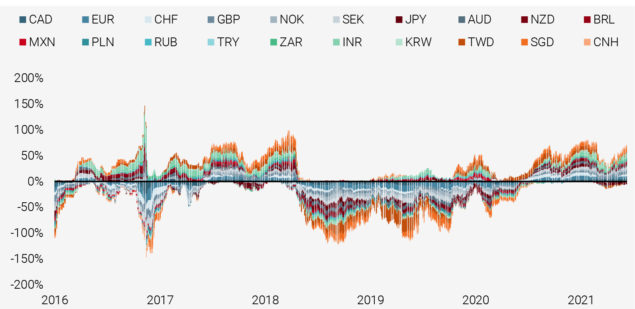
Source: Bloomberg, Unigestion. Data as at 31.05.2021.
Our outlook expectations – stronger growth than markets and investors are anticipating, patient central banks, equity markets dominated by rotation rather than directionality, rates rising but gradually, volatility not breaking range – suggest room for the risk premia of equities and real assets to compress further over the coming months.
Important information
This document is provided to you on a confidential basis and must not be distributed, published, reproduced or disclosed, in whole or part, to any other person.
The information and data presented in this document may discuss general market activity or industry trends but is not intended to be relied upon as a forecast, research or investment advice. It is not a financial promotion and represents no offer, solicitation or recommendation of any kind, to invest in the strategies or in the investment vehicles it refers to. Some of the investment strategies described or alluded to herein may be construed as high risk and not readily realisable investments, which may experience substantial and sudden losses including total loss of investment.
The investment views, economic and market opinions or analysis expressed in this document present Unigestion’s judgement as at the date of publication without regard to the date on which you may access the information. There is no guarantee that these views and opinions expressed will be correct nor do they purport to be a complete description of the securities, markets and developments referred to in it. All information provided here is subject to change without notice. To the extent that this report contains statements about the future, such statements are forward-looking and subject to a number of risks and uncertainties, including, but not limited to, the impact of competitive products, market acceptance risks and other risks.
Data and graphical information herein are for information only and may have been derived from third party sources. Although we believe that the information obtained from public and third party sources to be reliable, we have not independently verified it and we therefore cannot guarantee its accuracy or completeness. As a result, no representation or warranty, expressed or implied, is or will be made by Unigestion in this respect and no responsibility or liability is or will be accepted. Unless otherwise stated, source is Unigestion. Past performance is not a guide to future performance. All investments contain risks, including total loss for the investor.
Unigestion (UK) Ltd. is authorised and regulated by the UK Financial Conduct Authority (FCA) and is registered with the Securities and Exchange Commission (SEC). Unigestion Asset Management (France) S.A. is authorised and regulated by the French “Autorité des Marchés Financiers” (AMF). Unigestion Asset Management (Canada) Inc., with offices in Toronto and Montreal, is registered as a portfolio manager and/or exempt market dealer in nine provinces across Canada and also as an investment fund manager in Ontario, Quebec and Newfoundland & Labrador. Its principal regulator is the Ontario Securities Commission. Unigestion Asset Management (Düsseldorf) SA is co-regulated by the “Autorité des Marchés Financiers” (AMF) and the “Bundesanstalt für Finanzdienstleistungsaufsicht” (BAFIN). Unigestion SA has an international advisor exemption in Quebec, Saskatchewan and Ontario. Unigestion SA is authorised and regulated by the Swiss Financial Market Supervisory Authority (FINMA). Unigestion SA’s assets are situated outside of Canada and, as such, there may be difficulty enforcing legal rights against Unigestion SA.
Document issued: July 2021.
